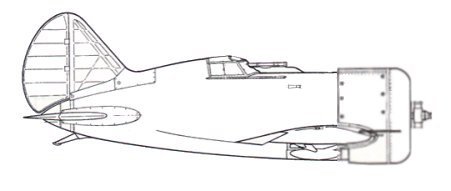
Engine: 480 h.p. M-22
Armament: 2 x 7.62mm ShKAS
Production: 55
Type 4

Engine: 480 h.p. M-22
Armament: 2 x 7.62mm ShKAS
Production: 55
The I-16 Type 4 was the first mass-produced model of the TsKB-12, reaching
squadrons in 1934.
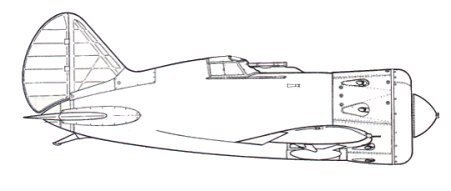
The original NACA type cowling of the Type 4 was quickly discarded in favor of a superior scalloped unit with cooling shutter grilles deployed along the cowl face. The M-25 poweplant accompanied the Type 5, along with a new pointed spinner. The exhaust opening 'blisters' on the Type 5 cowling were slighty more 'teardrop' shaped than on later units, although some 1938 manufacture Type 5s demonstated the later 'rounded' arrangement. The enclosed canopy was retained for much of the Type 5's production, as was the original outer wing structure.
During their service in the early phases of the Spanish
Civil War, the firepower of the Type 5 (with only two rifle-caliber guns) was
seen to be inadequate by most Republican pilots. A rather ad-hoc solution was
put forward by the staff at Zavod 21 (Gor'ki), who modified some 30 aircraft
at the factory to mount an additional 7.62mm ShKAS gun in the lower engine cowling.
Alas, the factory records do not specify the exact location. However, there
apparently exists one photograph of such a machine in Spain (which I have not
yet examined), and although poor, seems to show the extra gun mounted at the
bottom of the cowling along the center-line, just as on the later Type 29. This
arrangement seems especially logical, and it is probable that all Type 6s looked
like this.
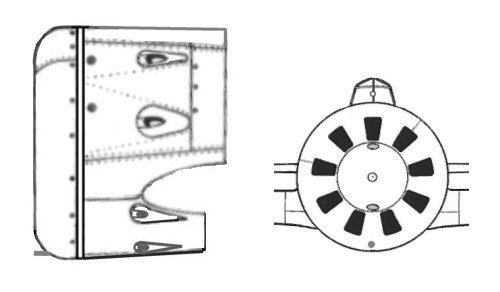
The resulting aircraft were known to the Gor'ki staff as "ispanskiy"
(Spanish) models, and not reported in any other way. The designation "Type 6"
is known only from records from the NKVD, and from a shipping manifest in their
archival collection. If this designation was used (and it seems it may have
been), then it would be known, presumably, only to the Soviet pilots in Spain,
and not in 'general' VVS service.
Type 6
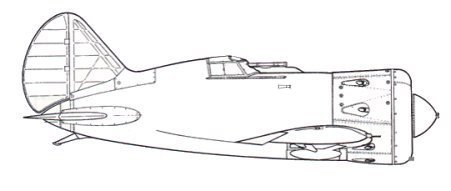
Additional armament options were investigated on the I-16 Type 5. In the latter months of 1937 a small number (two dozen, or so) of Type 5 machines (of the earlier pattern) were completed at Zavod 21 with a pair of 20mm ShVAK cannon in the wings replacing the usual ShKAS guns. These 'gun-ship' models were reported as the Type 12, and were viewed with great enthusiam by Narkomaviaprom. Another dozen were manufactured in January 1938 (of mixed Type 5 configuration), bringing the total to some 35 in all.
Production of the Type 5 continued well into 1938 and even 1939, and by this time the Type 10 model was already in manufacture. Many of the refinements of the Type 10 were applied to manufacture of the Type 5 during this period. The sliding canopy was replaced by the Type 10's fixed windscreen, and the outer wing sections were of the new improved and more rigid variety, though the Type 5s retained their larger ailerons.
Type 5, 1938
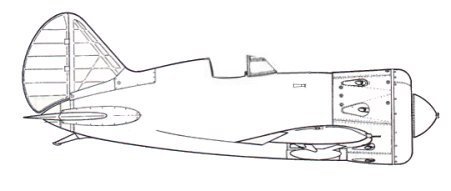
These later production Type 5 machines were highly prized for their handling,
and were widely regarded as the most maneuverable and well-behaved of the entire
family of I-16 fighters.
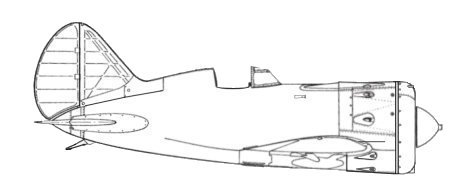
The I-16 Type 10 embodied a number of refinements as seen on later Type 5 production, such as improved outer wing sections and a new fixed windscreen. Additional power was provided by an uprated M-25V radial. The Type 10 introduced the new four gun armament scheme of a pair of ShKAS guns in both the wings and upper fuselage. The internal fuel cell received two troughs to make room for the extra 7.62mm guns, resulting in a moderate decrease in range; these weapons were externally obvious by the new blister fairings above the engine. The cowl face also demonstrated a new 'T' shaped intake along the lower forward edge, resulting in a slightly changed profile.
The wings were further modified by the installation of shorter ailerons, these
terminating at the wing section joint. A set of landing flaps were introduced
underneath the inner wing section span and fuselage bottom to reduce the I-16's
extravagant landing speed. However, the use of these flaps resulted in poor
low-speed behavior, and they were seldom employed by operational units.
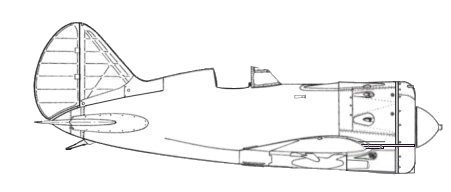
Many VVS pilots shared Narkomaviaprom 's enthusiasm for cannon armed fighters, and instructions were issued to manufacture a 'gun-ship' version of the I-16. The resulting Type 17 was really little more than a Type 10 with two 20mm cannon mounted in the wings replacing the usual ShKAS. Performance did suffer as a result of the extra weight, but the 20mm ShVAK was a very powerful weapon and many pilots preferred the heavier 'gun-ships' to their machine-gun armed counterparts.
The Type 17 introduced a revised engine cowling. The new unit featured cut-outs along the bottom surface to accomodate ski-type landing gear when fitted. The skis folded like normal landing gear to lie flush in these troughs, improving streamlining. To make room, the engine exhaust stacks were repositioned so that there were now six blisters rather than eight, and thus the lower blisters contained two exhaust pipes. As well, the lower intake of many Type 17s was rectangular, and not 'T' shaped as on the Type 10.
As more powerful engines became available to the I-16 programme, the desire to produce updated 'gun-ship' models followed them. Mounting the 800 h.p. (900 hp for Take-off and Emergency) M-62 engine, the Type 17 became the Type 27. A new rounded spinner accompanied a new constant-speed propeller (as on the Type 18), as was always the case with the I-16's propeller hub (or, in other words, the spinner usually matched the motor). In all, 59 Type 27s were completed during 1939.
Type 27
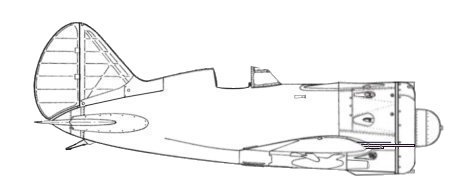
The very last examples of the Type 27 made use of the remaining components of
Type 18 manufacture (which was being replaced by the Type 24), apparently including
in some cases the entire fuselage assembly. Thus, one will occasionally see
a photo of a Type 27 sporting underwing rockets, and other such later features.
The last 'gun-ship' model, the Type 28, was also based initially on the Type 17. This variant was powered by the 930 h.p. (1100 hp for Take-off and Emergency) M-63, complete with accompanying spinner and cowling changes.
Type 28
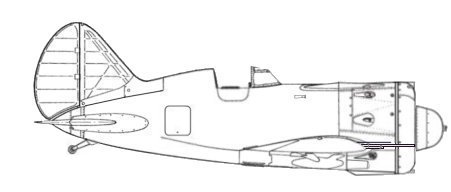
Many models designated 'Type 28' were manufactured using components from incomplete
Type 24 machines, and featured some or all of the improvements made to the new
airframe. A number of these, in fact, were simply Type 24s with two ShVAK mounted
in the wings, and it is not uncommon to find Type 28s in the photographic record
with underwing fuel tanks, tail wheels, starboard cockpit and radio doors, gun-camera
mounts, and other Type 24 refinements. At least 293 Type 28s were completed
altogether.
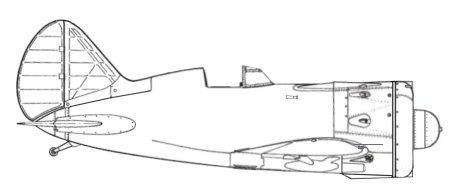
The desire to boost the I-16's performance led to the introduction of increasingly powerful engines. The Type 18 was a further refinement to the Type 10, now mounting the M-62 radial of much greater power. In addition, there were structural modifications to the wing outer sections (not visible externally).
The biggest change in appearance came from the new cowling. This unit featured
a new triangular intake (supercharger) along the top of the cowling's forward
face, giving a rather 'squarish' profile. The lower intake seems to have reverted
to the Type 10's 'T' configuration once more. As well, an additional fairing
was added to the bottom of the cowling (housing an improved oil cooler), contributing
to the unit's angular lines.
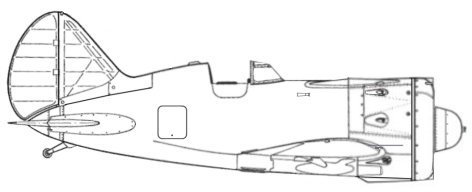
The brief production window for the Type 18 reveals that the model was merely a transitional stop-gap as manufacture of a newer standard emerged. Indeed, the Type 24 was the result of all of the design considerations developed from the Type 10 and 18. The new model was powered by the M-63 radial of 930 h.p. (1100 hp for Take-off and Emergency), and the earlier tail skid was replaced with a tail wheel for better ground handling. Although the cowling was very similar to that used on the Type 18, the shape of the bottom inlet changed once more to an inverted 'T' configuration, and a new spinner accompanied the M-63.
The wing outer sections were improved once more without obvious external notice
(thicker leading edge skinning, etc.), and the armament remained unchanged from
the Type 18. The fuselage, however, sported several new features, including
a second pilot access door to starboard and a large radio access hatch on the
same side of the fuselage. An optional mounting bracket for a gun-camera was
often seen above the cockpit, and new stores such as fuel drop tanks and rockets
could be carried under the wings (later Type 18s could accommodate rockets,
as well).
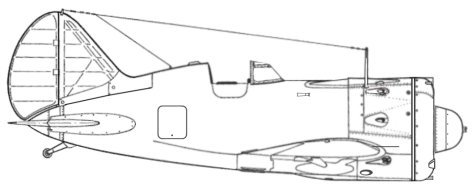
The last of the venerable I-16 fighters was the Type 29, again powered by the M-63. In fact, the Type 29 was very much a refined Type 24, utilizing much of the same structure. Searching for ever greater performance, efforts were made to reduce weight in the new variant. To this end, the wing ShKAS guns were removed and replaced by a single UBS of heavier caliber in the lower engine cowling (a la the Type 6). A new rounded fairing was installed on the cowling bottom surface, complete with a spent cartridge ejection slot.
The installation of the UBS gun on the lower cowl center-line required the displacement of the lower intake to the starboard side, resulting in a very different head-on appearance. A number of Type 29s, however, did not feature the lower oil cooler intake, and these models can be identified by two oval cut-outs in the the lower starboard side of the cooling louvre on the cowl face. An external radio mast also usually appeared on the same side, mounted at an angle (provision for the improved RSI-3), and supporting aerials running back to the vertical fin. One last modification involved the arrangement of the landing gear, in which the wheelbase was widened from 380m to 421mm, and the oleo stroke reduced by 32mm. In all other respects, the Type 29 was similar to the preceding Type 24.